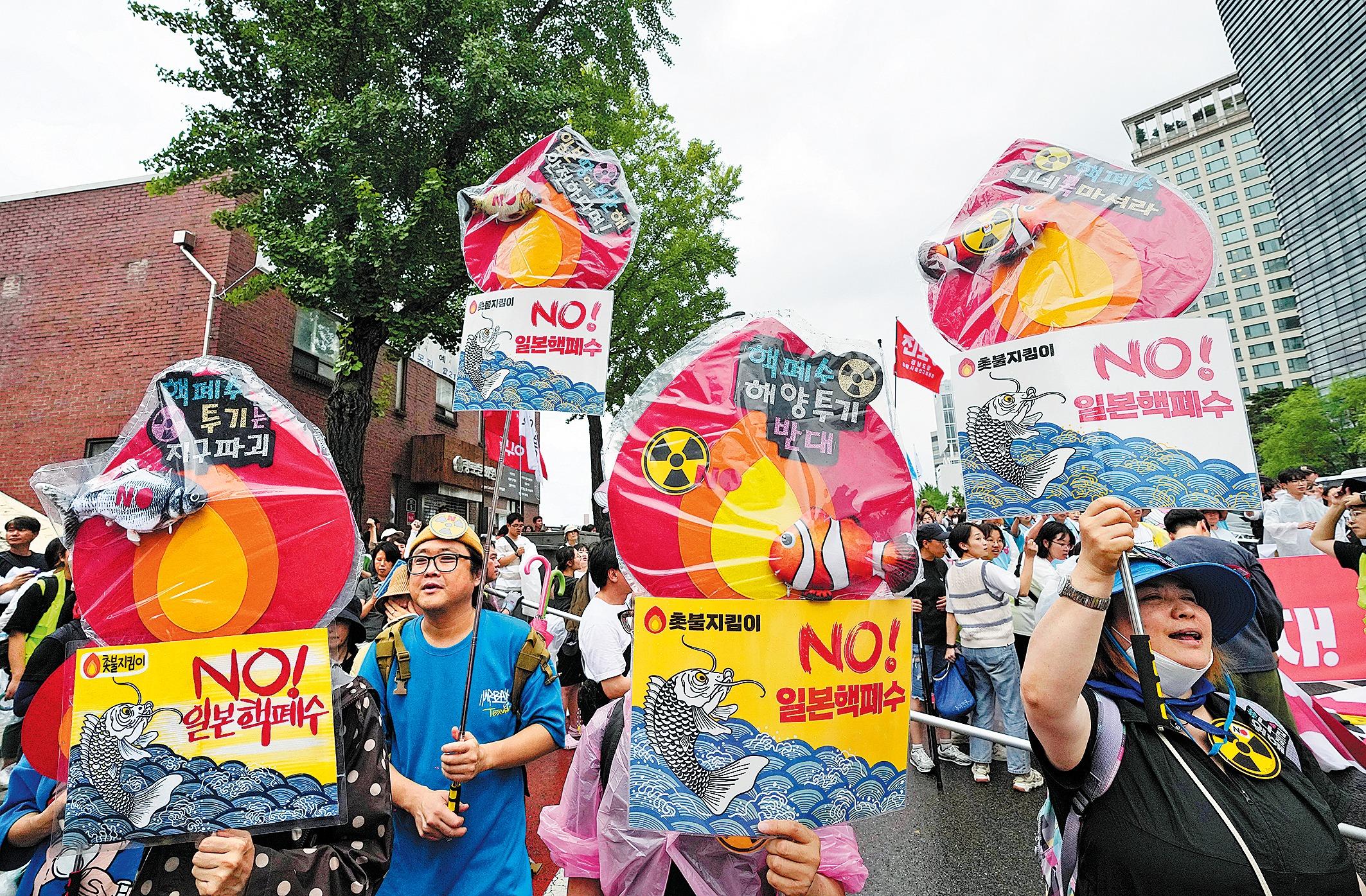Dumping wastewater into Pacific is breach of convention and driven by self-interest, say experts
 Protesters stage a rally against the Japanese government’s plan to release nuclear-contaminated water into the sea, near a building that houses the Japanese embassy in Seoul on July 15. (PHOTO / AP)
Protesters stage a rally against the Japanese government’s plan to release nuclear-contaminated water into the sea, near a building that houses the Japanese embassy in Seoul on July 15. (PHOTO / AP)
Japan’s plan to discharge nuclear-contaminated water into the ocean is in clear breach of the obligations outlined in the United Nations Convention on the Law of the Sea (UNCLOS), said legal experts, as protests against Tokyo’s proposal continued.
As a signatory to the UNCLOS, Japan is obligated to comply with its provisions.
Article 192 of the Convention says, “States have the obligation to protect and preserve the marine environment.”
Further, Section (a) of Clause 3 of Article 194 discusses necessary measures to minimize the leak of polluting substances, saying these measures shall include those designed to minimize, to the fullest possible extent, the release of toxic, harmful or noxious substances, especially those which are persistent, from land-based sources, from or through the atmosphere or by dumping.
Discharging nuclear-contaminated water containing radioactive substances into the ocean violates the provisions of these regulations, said Etsuro Totsuka, a Japanese human rights lawyer.
Totsuka told China Media Group that even if such nuclear-contaminated water is discharged within a country’s territorial waters, it will eventually flow into the high seas, which are the common heritage of mankind.
Radioactive substances accumulate through marine life, such as fish, and people consume these contaminated seafood products. It is not just the Japanese people who consume them. Chinese, Koreans, and people from Pacific Island nations will be equally affected. Therefore, this is not something that Japan can decide on its own, he said.
Totsuka is a member of the Japan Federation of Bar Associations. Last year, the federation expressed its opposition to the idea of ocean discharge in an opinion letter, noting concerns about the water treated by the Advanced Liquid Processing System (ALPS).
“The government and the Tokyo Electric Power Company (TEPCO) should explore alternative methods for treating contaminated water from the Fukushima Daiichi nuclear power plant, instead of ocean discharge,” the federation said.
The Citizen’s Commission on Nuclear Energy has repeatedly emphasized the need to review the mid-to-long-term plan to decommission the plant and has presented realistic alternatives to avoid the ocean discharge of contaminated water.
“Forcing the ocean release against the opinions of residents and citizens could hinder the decommissioning and recovery efforts, causing disadvantages to all stakeholders, including Fukushima prefectural residents,” the commission said in a statement in July.
“The government and TEPCO should retract the decision on the release of treated contaminated water and initiate fundamental discussions, including a review of the decommissioning schedule. They should immediately begin considering alternative solutions that do not involve ocean discharge,” the commission said.
In the absence of a fundamental solution to Japan’s nuclear-contaminated water strategy, the decision to opt for ocean discharge was, in reality, driven by national self-interest, said Jin Ying, a research fellow with the Institute of Japanese Studies at the Chinese Academy of Social Sciences.
Over the past decade, the Japanese government and TEPCO have not invested significant resources in effectively managing nuclear-contaminated water, nor have they shown a genuine commitment to fundamentally eliminating environmental safety threats, Jin said in an article published in the journal Japanese Studies earlier this year.
To uphold the nuclear industry and fulfill the need for green development, the Japanese government’s top priority is to preserve TEPCO as a major player in the industry, Jin said, adding that they have opted for the easy way out by discharging the nuclear-contaminated water into the sea.
The “pro-ocean discharge” faction — comprising TEPCO, Japan’s Nuclear Regulation Authority, the Ministry of Economy, Trade and Industry, and the Japanese Prime Minister’s Office — remained committed to the predetermined ocean discharge route, despite numerous flaws, Jin noted.
Meanwhile, protests against the plan continued in South Korea and Japan.
Lee Jae-myung, chairman of the main opposition Democratic Party, sent a letter to Japanese Prime Minister Fumio Kishida on July 28, urging him to suspend the planned discharge.
In the letter delivered via Japanese diplomats in Seoul, Lee expressed South Korean people’s concern and opposition to the planned release, DP’s chief spokesman Kwon Chilseung said on July 31, according to Xinhua News Agency.
Lee listed five proposals in the letter, including launching a standing consultative body for environmental impact assessment and finding safe alternatives together through cooperation with the international community.
Japanese and South Korean civic groups gathered in front of the Japanese prime minister’s official residence on July 31, where protesters said the ocean discharge plan is unacceptable because it poses a significant danger of radioactive contamination and will adversely affect the marine ecosystem and human health.
The South Korean Committee against Ocean Discharge of Contaminated Water from Japan’s Fukushima Nuclear Power Plant voiced similar concerns.
The International Atomic Energy Agency said in early July that it found Japan’s plan to release nuclear-contaminated water into the sea consistent with international standards, but stressed that it does not mean approval of the plan.
Contact the writers at jiangxueqing@chinadaily.com.cn


